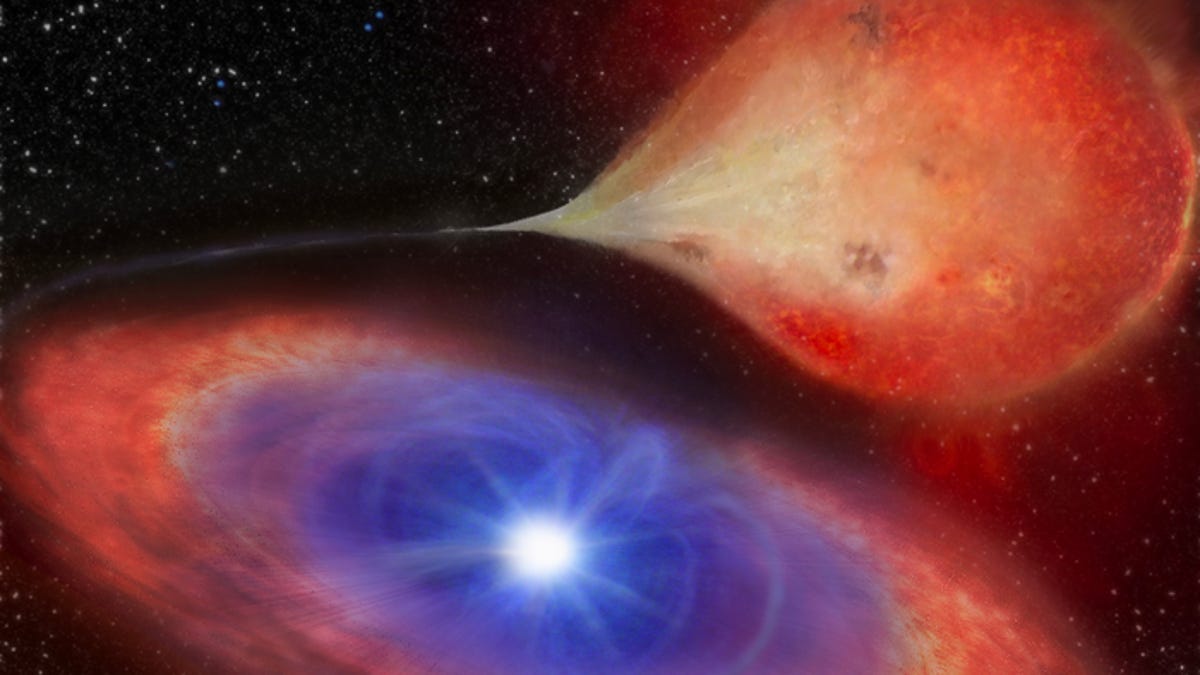NASA planet-hunting telescope spots a dying star switching on and off
A white dwarf couldn't swallow any of its star food floating nearby. That forced its lights to go out.

An artist's impression example of a white dwarf accreting as it draws in material from a companion star.
Deep within the cosmos, a fading star's quiet death was sharply interrupted. Instead of gracefully vanishing into the heavy darkness of space, as stars typically do, it coughed out a mysterious, prolonged flicker of light.
This "has never been seen in other accreting white dwarfs," Simone Scaringi, an astronomer at Durham University's Centre for Extragalactic Astronomy in the United Kingdom, said in a statement. "It appears to be switching on and off." Scaringi is lead author of a study on the star published Monday in the journal Nature Astronomy.
Every iridescent star that decorates our universe -- and those yet to add to the glittering collection -- will one day disappear. Slowly but surely, their luster, fueled by heaps of hydrogen gas, will dwindle as the supply runs out. Entering their final stages of life, they will become white dwarfs.
And NASA's Transiting Exoplanet Survey Satellite, or TESS, caught a unique glimpse of this particular white dwarf's strange behavior. The dying star is part of the two-star system dubbed TW Pictoris, located 1,400 light-years away.
"To see the brightness of TW Pictoris plummet in 30 minutes is, in itself, extraordinary," Scaringi said. His team believes the star unexpectedly lost illumination because of a sudden hurdle in its food-funneling mechanism. Basically, the shiny space ball's fiery snacks were falling out of reach.
White dwarfs feast on their companion stars by pulling flaming bits of the body into their Saturn-like ring of matter, or accretion disc, held in place by suspended magnetic fields. Swallowing a delicious bite makes a white dwarf literally light up with glee.
But these gently glimmering orbs are expected to pace themselves while feeding off their companion stars, meaning the sparkly spheres' luminescence should dim gradually as they finish their dinner. Darkness isn't anticipated to happen all at once, the way it did with TW Pictoris.
"The brightness variations seen in accreting white dwarfs are generally relatively slow, occurring on timescales of days to months," Scaringi said. That's why, he explained, TW Pictoris' white dwarf switching off is "totally unexpected from our understanding of how these systems are supposed to feed through the accretion disc."
In decoding the puzzle, the team found that during its "off" phase, the white dwarf's accretion disc was spinning so fast it induced a centrifugal force strong enough to prevent the disc's matter from ever reaching the central star. That's why the expiring stellar object didn't have anything to gobble on, thereby limiting its light. Such regulation, according to the research, is called magnetic gating.
The phenomenon is similar to what happens when you ride a roller coaster and enter a loop. A rider wouldn't fall into the loop due to the force that presses the passengers into their seats.
After the "off" phase and during the "on" phase, the disc's speed of rotation went back to normal. Matter could, once again, escape the grips of the spin for the white dwarf to snack on.
"This really is a previously unrecognized phenomenon," Scaringi explained, adding that "because we can draw comparisons with similar behavior in the much smaller neutron stars, it could be an important step in helping us to better understand the process of how other accreting objects feed on the material that surrounds them, and the important role of magnetic fields in this process."

